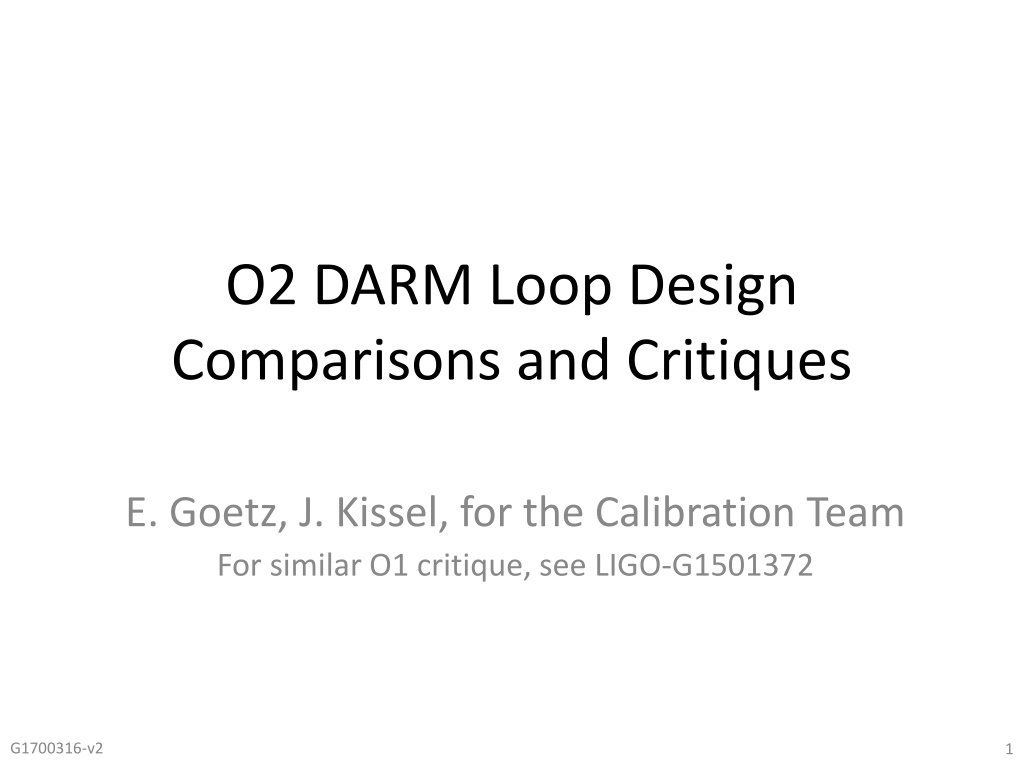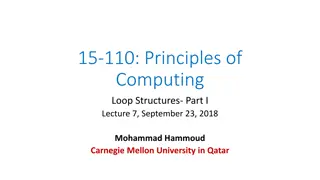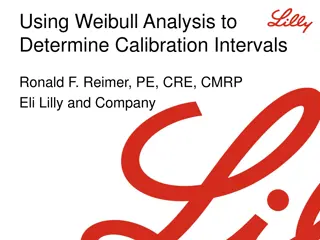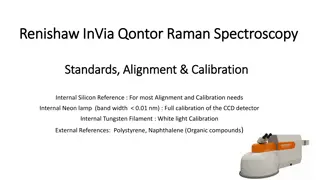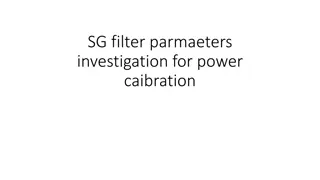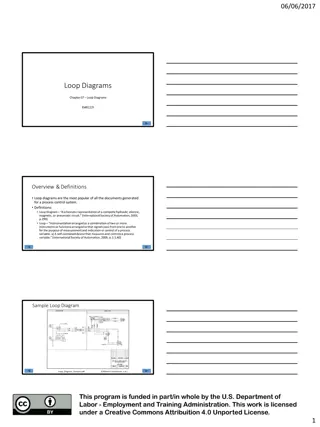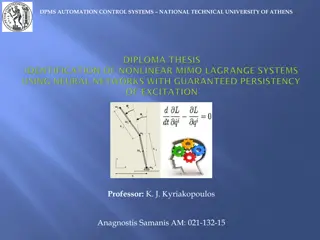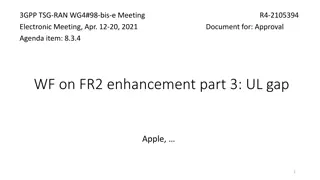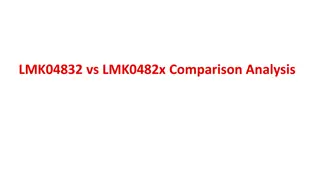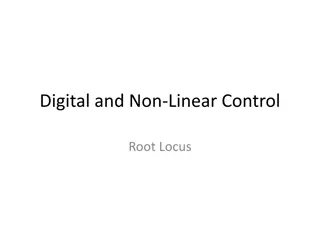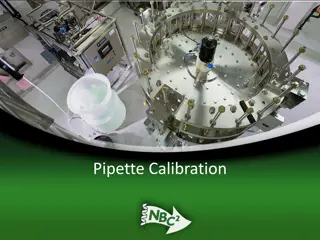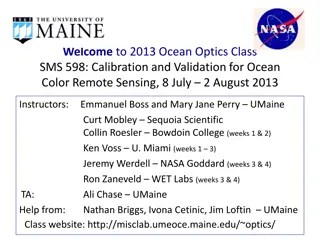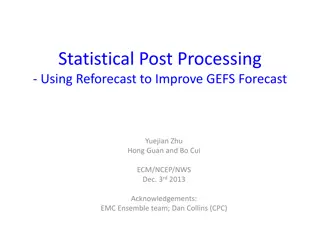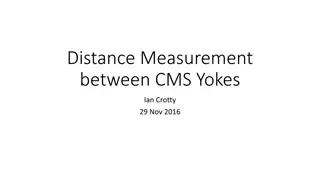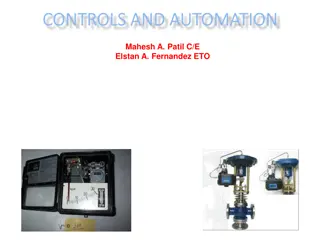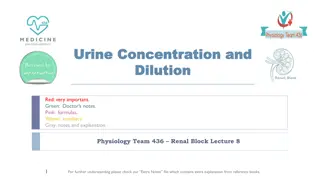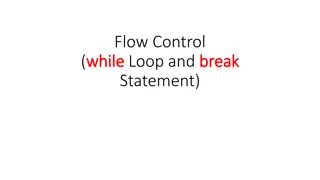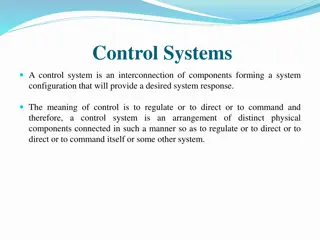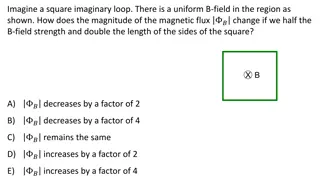Comparison and Critique of DARM Loop Design for Calibration Team
This document provides detailed comparisons and critiques of the DARM loop design, focusing on aspects such as open loop gain transfer function, actuator strength, hierarchy filters, and DARM filter and sensing function. Key points include variations in UGF, phase margins, gain margin, actuator comparisons, and loop shaping strategies between sites. The report emphasizes the need for balance in gain distribution and sign compensation to achieve optimal loop shaping.
Download Presentation

Please find below an Image/Link to download the presentation.
The content on the website is provided AS IS for your information and personal use only. It may not be sold, licensed, or shared on other websites without obtaining consent from the author. Download presentation by click this link. If you encounter any issues during the download, it is possible that the publisher has removed the file from their server.
E N D
Presentation Transcript
O2 DARM Loop Design Comparisons and Critiques E. Goetz, J. Kissel, for the Calibration Team For similar O1 critique, see LIGO-G1501372 G1700316-v2 1
DARM Open Loop Gain TF (Big Picture) Roughly the the same UGF H1 has notched out 2 kHz and above violin modes H1 still may need more gain at low frequency Good compromise on aggression of filtering G1700316-v2 2
DARM OLGTF (UGF Zoom) L1 UGF: 57.5 Hz H1 UGF: 68.4 Hz Good compromise on aggression of filtering H1 Phase Margin: 39.4 deg L1 Phase Margin: 31.4 deg G1700316-v2 3
DARM Open Loop Gain TF L1 Max Suppression: 1.9 H1 Max Suppression: 1.9 Both have plenty of gain margin H1 has a couple of orders of magnitude less suppression around the microseism G1700316-v2 4
Actuator Strength Comparison G1700316-v2 5
Actuator Strength Comparison FIXED: L1 now includes all harmonics in the suspension model Different PUM COILOUTF convention PUM and TST have different signs G1700316-v2 6
Actuator Comparison (Hierarchy Filters) Both sites have a mish-mash of offloaded vs. distributed hierarchy filters due to staggered design L1 does more loop shaping in the DARM bank (because of all the notching done at H1) Note the difference in HF cut-off filter for all stages G1700316-v2 7
The DARM Filter and Sensing Function H1 boosts LF in the DARM bank Digital gains (and a sign) are distributed differently on the sensing side, so DARM filter gain and sign compensate, otherwise pretty similar actual optical gain: ~3 mA/pm at both sites But because of the different design choices, with frequency response and gains all over the place, tough to get a feel for the loop shaping from just one filter or plot SEE APPENDIX A FOR FURTHER DISCUSSION G1700316-v2 8
L1 Actuator Authority (Big Picture) Strength = from DRIVEALIGN OUT to Test Mass Displacement Authority = from LOCK IN to Test Mass Displacement Authority re-mathed to show it as a Distributed system, so cross-over frequencies mean something L1 does all their LF boosting in the actuator filters Just a bit of light notching, not too aggressive of a HF cut-off G1700316-v2 9
L1 Actuator Authority (X-over Zoom) UIM/PUM Cross-over: (Ill- defined, but PUM is rolled off by) 0.45 Hz Cross-over stability kinda risky here, but it s hard! PUM / TST Cross-over: 20 Hz Cross-over stability pretty good! G1700316-v2 10
L1 Actuator Authority (HF Roll-off Zoom) PUM is nicely rolled off above cross-over, but there s still some phase interaction that causes some icky wiggles in the total TF of the super actuator G1700316-v2 11
H1 Actuator Authority (Big Picture) Shown to same scale as L1 on Slide 9 Don t be alarmed: remember H1 does its boosting in the DARM bank (will show with DARM filter later) Loooooot of high- frequency notching FIXED: no ridiculous cutoff Interesting: UIM Bounce and Roll notches aren t as aggressive filter G1700316-v2 12
H1 Actuator Authority (X-over Zoom) Shown to different scale from L1 on Slide 10 UIM/PUM Cross-over: (Ill- defined, but PUM is rolled off by) 0.45 Hz Similarly risky cross-over here, but it s hard! PUM / TST Cross-over: 22 Hz G1700316-v2 13
H1 Actuator Authority (HF Roll-off Zoom) FIXED! G1700316-v2 14
Authority Including DARM Filter (scaled by optical gain) Looks pretty DARM clean! G1700316-v2 15
Authority Including DARM Filter (scaled by optical gain) FIXED: Boost similar to L1 s FIXED: Looks much better G1700316-v2 16
Conclusions H1 DARM Loop has been cleaned up since O1 FIXED: More boosting at low-frequency FIXED: Better / simpler distribution filters Less notching? Frequency response is splayed out everywhere at both sites, evident that design was staggered and piecemeal Both sites should consider consolidating, for easier analysis of performance G1700316-v2 17
APPENDIX A: Sensing Function Units Volts Volts Amps Watts Watts Differential Arm Displacement meters IFO Optical Response DCPD Quantum Efficiency OMC Beam Splitter Ratio Transimpedance Amp Whitening Chassis AA Chassis Volts Analog Gain we can t measure independently easily with high precision IO Chassis Commonly Used Used by L1 Used by H1 Units ADC Digital AA Translucent colors means it exists but not used IO Process ADC Counts DCPD Balance Matrix OMC OMC DCPD DCPD SUM DARM_ERR Counts mA DARM Offset mA DARM Offset OMC OMC READOUT SIMPLE + READOUT SCALE LSC DARM + LSC LSC INPUT MATRIX LSC OUTPUT MATRIX OMC_DC + 2 1 OMC READOUT ERR LSC DARM1 LSC DARM2 + Fringe Length + Power + 0.5 DARM Offset Normalization DARM Offset DARM Offset Contrast Defect Quadratic Coefficient x LSC ARM OUTPUT MATRIX h1omc USER model Why are the sensing functions (in [ct/m]) so incredibly different (6 orders of magnitude) between sites? To ETM SUS Models via IPC This has entirely and only to do with a different choice of digital allocation of gains. G1700316-v2 18
APPENDIX A: Sensing Function Units Both sites convert raw DCPD ADC counts into [mA] ADC Counts mA Counts (Transimp. Amp)-1 switchable A -> mA (ADC Gain)-1 G1700316-v2 19
APPENDIX A: Sensing Function Units Both sites balance and add the DCPDs to create ${IFO}:OMC-DCPD_SUM_OUT_DQ Empty (Unity Pass Through) at both sites ${IFO}:OMC-DCPD_SUM_OUT_DQ Coefficients very close to unity see e.g. LHO aLOG 29856 for how this is calculated Balancing Matrix G1700316-v2 20
APPENDIX A: Sensing Function Units But from here, they depart from each other soley due to how, historically, the sites were commissioned in parallel Bypassed for simplicity in Oct 2013 (see LHO aLOG 9100), and never looked back DC Readout Normalization Scheme developed in eLIGO, T0900023 (re)commissioned for aLIGO in May-July 2015 (see e.g. LHO aLOG 19233, 18470) G1700316-v2 21
APPENDIX A: Sensing Function Units The scale factors are geared such that DARM_ERR is in pm so the OFFSET in the DARM bank can be the DARM OFFSET in physical units. While there were efforts to calibrate DARM_ERR into displacement units, it all boils down to whether DARM ERR needed to originally be in pm or um and was never reconciled: Collectively it s about 1/ (4.5 [mA/pm]) ~ 0.2 unity passthroughs 100 pm -0.0229 12.6 um ~0.048 196 ~0.07 ~ -8.7e-7 ~14.2 In other words, both sites are normalizing their DARM loop gain to some reference time with the optical gain was ~ 4.5 / 2.7 [mA/pm] This gain factor is such that the OMC DCPD error signal matches the AS AIR, and AS AIR error is matched to ALS DIFF, which was originally (roughly) calibrated in um Scale factor collectively works out to about 1e-6 [um/pm] / (2.7 [mA/pm]) ~ 3.6e-7 G1700316-v2 22
APPENDIX A: Sensing Function Units Volts Volts Amps Watts Watts Differential Arm Displacement meters IFO Optical Response DCPD Quantum Efficiency OMC Beam Splitter Ratio Transimpedance Amp Whitening Chassis AA Chassis Volts Analog Gain we can t measure independently easily with high precision IO Chassis Commonly Used Used by L1 Used by H1 Units ADC Digital AA Translucent colors means it exists but not used IO Process ADC Counts DCPD Balance Matrix OMC OMC DCPD DCPD SUM DARM DARM_ERR Counts Filter Gain ~1e2 EPICs Gain 0.57 mA DARM Offset mA DARM Offset pm OMC OMC READOUT SIMPLE + READOUT SCALE LSC DARM + LSC LSC INPUT MATRIX um LSC OUTPUT MATRIX OMC_DC + 2 1 OMC READOUT ERR LSC DARM1 LSC DARM2 + Fringe Length + Power + 0.5 DARM Offset Normalization DARM Offset DARM DARM Offset Contrast Defect Quadratic Coefficient x LSC Filter Gain ~1e10 EPICS Fain 1400 ARM OUTPUT MATRIX h1omc USER model And as we ve seen on pgs 2, 15 and 16, the open loop gains and actuation authority are virtually identical, so that gain discrepancy is made up for in the DARM banks. To ETM SUS Models via IPC Side note: as of O2, L1 still hasn t split their DARM bank into two, and that s shown here G1700316-v2 23
APPENDIX A: Sensing Function Units Phase [deg] Magnitude [ct/mA] 180 135 90 45 135 180 1.5 2.5 3.5 45 90 H1 10 10 0 2 3 4 x 10 This explains the difference between the site s transfer function between the OMC DCPD SUMM (in [mA]) and DARM_IN1 (i..e DARM_ERR in [ct]) 0 0 7 H1DARM_IN1 / OMC_DCPD_SUM Digital TF 10 10 Data From Mar 21 2017 22:19:25 UTC 10 1 1 Frequency [Hz] Frequency [Hz] 10 10 2 2 Phase [deg] Magnitude [ct/mA] 180 135 0.15 0.25 90 45 135 180 0.1 0.2 45 90 L1 10 0 0 0 2.8537e 07 [ct/mA] Raw Data 10 10 3 3 L1DARM_IN1 / OMC_DCPD_SUM Digital TF 10 10 Data From Mar 22 2017 19:52:00 UTC 1 1 created by sensing_in_mApm on 04 Apr 2017 Frequency [Hz] Frequency [Hz] So, if we use this entirely digital transfer function to correct (namely, undo) the sensing function from DARM_ERR counts to mA on the DCPDs, we get . 10 10 2 2 10 10 0.17897 [ct/mA] Raw Data 3 3 created by sensing_in_mApm on 04 Apr 2017 G1700316-v2 24
APPENDIX A: Sensing Function Units Phase [deg] Magnitude [mA / pm] The modeled optical gain is about ~3.7 [mA / pm] for both observatories (and remember, measurement matches our model very well). 180 135 10 10 10 90 45 135 180 45 90 1 0 1 10 10 0 0 0 H1 10 10 2017 01 03 H1 Sensing Function Model BUT, that mA is an function of how well commissioners filled out the DCPD banks namely the V2A and HiZ filter modules in the OMC DCPD Banks 1 1 DARM Offset = 11.18 [pm] Optical Gain = 3.813 [mA/pm] Model Frequency [Hz] 10 10 2 2 Phase [deg] Magnitude [mA / pm] 180 135 10 10 10 90 45 135 180 45 90 1 0 1 10 10 0 10 10 0 0 3 3 L1 created by sensing_in_mApm on 04 Apr 2017 10 10 2017 01 24 L1 Sensing Function Model 1 1 DARM Offset = 12.32 [pm] Side notes: - the sites also chose different sides the the quadratic for the DARM offset, so the phase is 180 different at low frequency. - Remember L1 doesn t include any SRC detuning, because they hadn t been able to measure it before O2 (now they have, see LLO aLOG 32495) Optical Gain = 3.63 [mA/pm] Model Frequency [Hz] 10 10 2 2 10 10 3 3 created by sensing_in_mApm on 04 Apr 2017 G1700316-v2 25
APPENDIX A: Sensing Function Units Conclusions On a loglog plot, the two sites have virtually identical sensing function optical gains in physical units, as expected. Phase [deg] Phase [deg] Magnitude [mA / pm] Magnitude [mA / pm] 180 180 135 135 10 10 10 10 10 10 90 90 45 45 135 135 180 180 45 45 90 90 1 1 0 0 1 1 10 10 10 10 0 0 0 0 0 0 The sensing function s optical gain in the DARM loop model is necessarily in unphysical units and very different in scale in order to cover the choices in digital gain distribution. 10 10 10 10 2017 01 03 H1 Sensing Function Model 2017 01 24 L1 Sensing Function Model 1 1 1 1 DARM Offset = 11.18 [pm] DARM Offset = 12.32 [pm] Optical Gain = 3.813 [mA/pm] Model Optical Gain = 3.63 [mA/pm] Model Frequency [Hz] Frequency [Hz] For the purposes of a paper, the sensing function can be scaled from the model s unphysical units to physical units using the transfer function between 10 10 10 10 2 2 2 2 10 10 10 10 3 3 3 3 LSC-DARM_IN1_DQ / OMC-DCPD_SUM_OUT_DQ But, if we want traceable accuracy and precision, we should be sure to understand how the digital filters in the DCPD banks were populated. created by sensing_in_mApm on 04 Apr 2017 created by sensing_in_mApm on 04 Apr 2017 G1700316-v2 26
